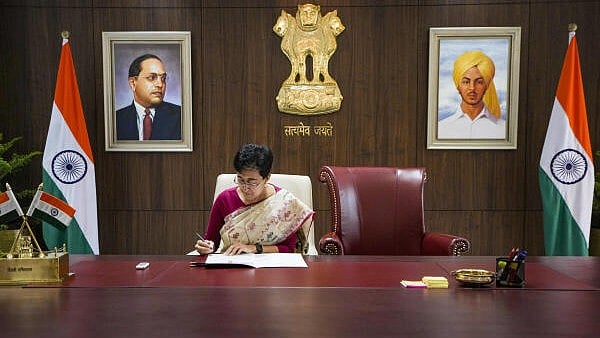
Delhi CM Atishi seen in the CM's office
Credit; PTI File Photo
The National Capital Territory of Delhi is just a few days away from electing new representatives for the next five years. The national capital is going to polls on February 5 and the results will be announced on February 8.
In its decades old history, the Legislative Assembly of Delhi has seen several ups and down from being the Imperial Legislative Council and Central Legislative Assembly of 1913-1926 to the Metropolitan Council of 1966-1990.
Since India's independence, Delhi has had eight chief ministers staring from Congress' Brahm Prakash to Aam Aadmi Party's Atishi. However, during the period between November 1, 1956 and December 2, 1993, Delhi did not have any chief minister or an Assembly.
Why was Delhi Assembly abolished?
The Delhi State Legislative Assembly came into being on March 17, 1952 under the Government of Part C States Act, 1951. This meant that Delhi would be a centrally administered state with its Legislative Assembly having limited powers. There were six other such states including Bhopal, Ajmer, Coorg, Bilaspur, Himachal Pradesh, and Vindhya Pradesh.
Continuing a pre-independence setup, there was a provision for a council of Ministers to aid and advice the Chief Commissioner in the exercise of his functions in relation to matters in respect to which the State Assembly was given powers to make laws.
After the 1951-52 elections, Brahm Prakash was sworn in as Delhi’s first Chief Minister. Prakash, however, during his tenure had several differences with the Chief Commissioner. The clashes finally ended with Prakash tendering his resignation on February 12, 1955.
The present day clashes between the chief ministers and Delhi Lieutenant Governors (LG) appointed by the Centre can be seen as a continuation of the previous disagreements, with just the name of the post having changed.
Following Prakash's resignation, Daryaganj MLA Gurumukh Nihal Singh was sworn in as the Chief Minister. His term, however, was short lived.
A few months after Singh assuming the office, the States Reorganisation Commission (1955) headed by Justice Fazl Ali submitted its report.
It said that “the future of Delhi has to be determined primarily by the important consideration that it is the seat of the Union Government”, and that it was “not surprising” that the “peculiar diarchical structure” in place at the time had “not worked smoothly”.
In pursuance of the recommendations of the Commission that “a separate state government” for Delhi was no longer required, Delhi ceased to be a Part-C State with effect from November 1, 1956. The Delhi Legislative Assembly and the Council of Ministers were abolished and Delhi became a Union Territory under the direct administration of the President.
In accordance with another recommendation of the Commission, the Delhi Municipal Corporation Act, 1957 was enacted constituting Municipal Corporation for the whole of Delhi with members elected on the basis of adult franchise.
Public and political pressure however continued asking for a democratic set up and statehood for Delhi.
In partial fulfillment of this demand and on the basis of recommendations of Administrative Reforms Commission, the Delhi Administration Act, 1966 was enacted. The Act provided for a deliberative body – called Metropolitan Council having recommendatory powers. At the top, there was Lt. Governor or Administrator who was appointed by the President of India.
The 69th amendment
This setup continued while politicians stepped up demands for Delhi's statehood and in 1987, the Union government appointed Sarkaria Committee (later on called Balakrishnan Committee) to submit a report on affective administration of Delhi. The Committee submitted its report in December, 1989 and recommended that "Delhi should continue to be a Union Territory but should be provided with a Legislative Assembly with appropriate powers to deal with matters of concern to the common man.
Based on the recommendations, the Parliament passed the Constitution (69th Amendment) Act, 1991, which inserted the new Articles 239AA and 239AB in the Constitution providing, inter alia, for a Legislative Assembly for Delhi.
These amendments came into effect in 1992, paving way for Assembly elections in November 1993. The elections were dominated by the BJP and Madan Lal Khurana was sworn-in as the third Chief Minister of Delhi after a gap of 37 years.
Delhi Assembly Election 2025 | The first of two state assembly polls this year sees a three-way contest between AAP, Congress, and BJP in the nation's capital. AAP decided to contest the polls alone, causing rumours of a rift in I.N.D.I.A. BJP, meanwhile, is hoping the liquor excise policy scam and pollution in Delhi will give the saffron party an edge over AAP. Kejriwal, on the other hand, has different plans with his demand for reservations for Delhi Jats. Congress will also be looking to make its presence felt and has not held back from attacking its own alliance partner. Check live updates and track the latest coverage, live news, in-depth opinions, and analyses only on Deccan Herald.
Subscribe and follow DH on Whatsapp, X, Facebook, YouTube, and Instagram to never miss out on anything.